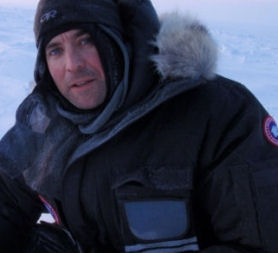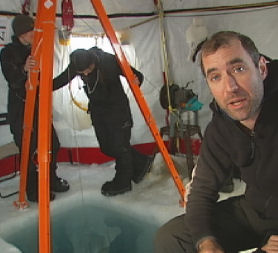Acid Arctic? What the ocean tells us about climate change
Science Correspondent Tom Clarke reports from the Canadian Arctic, where scientists are investigating ocean acidification – one of the least publicised but most worrying effects of climate change.
Five years ago, no-one outside a very small group of ocean scientists had heard of ocean acidification.
Now, it is one of the most worrying phenomena confronting those who care about the radical changes that seem to be happening on our planet.
Worrying enough to compel a team of three UK scientists to camp on the sea ice floating on top of the Arctic Ocean for 35 days in conditions as tough as anywhere on the planet.
I’ve just returned from their camp where I was given exclusive access to this unique team who are trying to understand how this phenomenon might be impacting the Arctic Ocean – and what the implications for our planet might be.

Their initial findings may suggest this pristine ocean is already more acidic than others, and that the chemical balance of the ocean may already be becoming unfavourable for the tiny plankton that live there.
Don’t care much about tiny plankton? Well you should. They form a fundamental cog in the ecological machinery that make the Earth a hospitable place for us to live.
And the scientists I spent a week with on the arctic sea ice care very much about plankton. Despite temperatures of 40 below freezing, the threat or frost bite and possible encounters with polar bears, they worked into the night (or should that be the never ending arctic daylight) trying to get the first picture of how these creatures are coping and how the chemistry of the Arctic Ocean below the ice might be changing.

I watched Dr Ceri Lewis, a marine biologist from the University of Exeter, hurry her samples of minute shrimp-like creatures called copepods from a hole she had cut into the ice into the lab.
Why the hurry? Insulated by the ice above, the sea is just two degrees below freezing, but the air above 20 below – or colder. “The cold affects everything we do,” Dr Lewis told me.
Even their water samples – essential for building a picture of how this ocean is changing – had to be stored in cool boxes. Not to keep them cool – but keep them warm enough to prevent them freezing solid before they can be analysed by specialist equipment back in the UK.

This was my first trip to the arctic ice. It’s something I’ve been reporting on for years. How it’s retreating, how the arctic is warming, how natural resource companies and the nations that back them are squaring up to each other across a Pole that will, in the not-to-distant future be completely free of ice.
But when I arrived in the Arctic the first thing that struck me was how seemingly unchanging the environment was. Everything was, well, frozen. Nothing moved, there was no wildlife, nothing but icy spindrift blowing in the wind. The Arctic Ocean looks completely static.
But my superficial impression is typical of what separates us ordinary folk from scientists patient and dispassionate enough to properly understand our planet. Because in fact the arctic is, quite rapidly, changing. The sea ice we camped on was just two metres thick.
A few decades ago, the average was twice that. A study, published in the journal Nature reveals how it’s this ice-sheet thinning, combined with it melting across much of the arctic sea, is probably behind the astonishing temperature rises seen in the arctic.
Ice weather for camping: Tom Clarke blogs from the Arctic
I'm glad we'll be in experienced hands. Floating sea ice isn't the easiest place to work. For a start the ice base is cold - -20o C right now with strong winds sometimes making it -35o C.
Add to the mix the possibility of cracks appearing in the ice and cutting our campsite in two.
Oh, and then there are polar bears, our planet's largest land predator. Encouragingly, they're well fed at this time of year and it's someone's job to be on guard for them 24 hours a day. But we've been told not to keep any food in our tents just in case...
Read more
This ocean is getting warmer about twice as fast as anywhere else on the planet. And that, simply, is why the scientists are there. Where climate change is happening fastest is where you expect to see its impact happening first.
And one of those impacts is ocean acidification. It’s emerging as one of the most disturbing camp followers of climate change. It’s caused by all that extra carbon dioxide we’re putting into the atmosphere dissolving into the sea, which has the effect of turning them more acidic.
This ocean is getting warmer about twice as fast as anywhere else on the planet.
The oceans aren’t actually becoming acid like lemon juice or vinegar but chemically they are heading in that direction. If it sounds trivial it’s not. The animals and plants that inhabit our seas lock up carbon dioxide by absorbing it from the ocean. But a more acid ocean means it’s a lot harder for that to happen.
Acidified oceans become worse at soaking up planet warming carbon dioxide. And that’s a big deal – like giant liquid rainforests – they currently mop up half of the carbon dioxide we churn out. When it comes to the Arctic, it couldn’t happen in a worse place.
Because it’s so cold, the Arctic Ocean absorbs more than its fair share of carbon dioxide. Even though it’s a small ocean compared to many, this makes it disproportionally important in cooling our planet.
If you want to get a picture of how grave the problem of ocean acidification may be – the Arctic is a smart place to start.

But it’s also a very difficult place to work – and that’s what makes the background to this expedition interesting. The scientists are being hosted by the Catlin Arctic Survey.
Established last year, Catlin Arctic Survey’s mission is to unite polar exploration with science. The idea: to allow the expertise of hardened polar explorers give scientists access to this most inhospitable of places. Last year their leader – polar veteran Penn Hadow – attempted to walk to the North Pole while measuring sea ice thickness.
His efforts were criticised in some corners – that the data gathered was superficial and that science is best left to the professionals – even though some eminent ice experts said the measurements filled important gaps in their knowledge. This year a team of professional explorers are headed to the pole again while collecting sea water samples.
But in addition, Catlin Arctic Survey set up the ice base we visited to allow this group of scientists long-term access to the Arctic Ocean at the crucial interface between the arctic winter and summer. Something no team looking at ocean acidification has benefitted from before.
Some purists might raise an eyebrow at the idea of corporations like Catlin, a speciality insurance firm, sponsoring science. But historically it’s nothing new. Some of the first scientific analysis of this frozen wilderness was conducted first by explorers.
And many of them were funded privately. The nearest land to our camp was mapped by pioneering Norwegian explorer Otto Sverdrup. His largely academic mission of 1899 to 1902 was funded by Norway’s biggest brewer. He named Ellef Rignes Island after them. Thankfully an act of branding that would today, make any boardroom blush.




